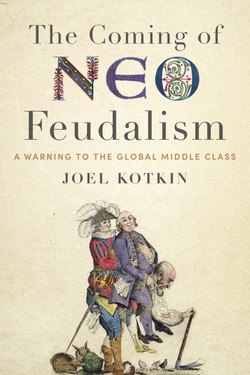Читать книгу The Coming of Neo-Feudalism - Joel Kotkin - Страница 20
На сайте Литреса книга снята с продажи.
ОглавлениеCHAPTER 10
The Rise and Decline of Upward Mobility
Far from the congenial warmth of the Mediterranean shores, the Netherlands sits on the cold and waterlogged fringe of northern Europe. The ancient inhabitants of the region, the Batavi, served Rome as auxiliaries but gave little in the way of tribute. They didn’t have much to trade, but they never lost their sense of independence. In the first century they rebelled against Roman imperial taxes, and though eventually defeated, they left an enviable reputation for ferocity.1 In time, this obscure race, nurtured on a hard-won spit of soggy land, would lead a shift in the balance of world power away from the Mediterranean, China, and the Islamic empire, toward a handful of small countries along the North Sea.
The Low Countries occupied a tiny corner of the continent, short in natural resources, but by the thirteenth century the inhabitants had begun to expand their territory by draining swamps and building dikes. Improvements in agricultural methods led to an early commercialization of the countryside and fueled a wider economic “takeoff”. As the economic historian Jan de Vries observed, “capitalism grew out of the soil in Holland.”2 The region was more urbanized than most of Europe, with a sizable population of artisans and prosperous merchants. In the sixteenth century, the northern provinces rejected Catholicism in favor of Calvinism, a creed more congenial to commerce.
After expelling their Spanish Habsburg rulers in the seventeenth century, the United Provinces built the world’s most powerful maritime empire, with a fleet larger than all the rest of Europe’s put together. Amsterdam’s port, where as many as eight thousand ships were docked, bustled with a rich trade in foodstuffs, hemp, hops, and dye plants. The opportunistic Dutch expanded their commercial activity in part by pioneering technological changes decades ahead of their competitors.3
But arguably the greatest achievement of the Dutch lay in creating a republic free from aristocratic or clerical domination, as the expulsion of the feudally inclined Spanish overlords empowered the bourgeoisie.4 The Dutch expanded human rights, including those of religious minorities and women, and cultivated a keen interest in children and the nuclear family. Dutch culture was family-centered, inventive, sober, frugal, and tolerant. A separation of science and philosophy from religion was exemplified in the writings of Baruch Spinoza, among others.5 Although majority Calvinist, the country boasted large colonies of Catholics, Jews, and other outsiders, including Muslims; roughly a third of Amsterdam’s population in 1650 were foreign-born. Some immigrants came as merchants or artisans, but even the poorest, observed one Dutchman in 1692, “cannot die of hunger if he works hard.”6
As late as the eighteenth century, the Dutch Republic was regarded as a poor country, and the British viewed it as “the indigested vomit of the sea.”7 But the reclaimed land helped raise a substantial class of small landowners at a time when most property in Europe was owned by the aristocracy or the church. The growing ranks of proprietors were the heart of Dutch dynamism, and they set down “the geographical roots of republican liberty,” notes the historian Simon Schama.8
The Rise of the Yeomanry
The Dutch Republic represents an early and robust growth of economic and social mobility, shaking up the more static, hierarchical order that was typical of the medieval world. A similar process would spread through western Europe and then far beyond.
